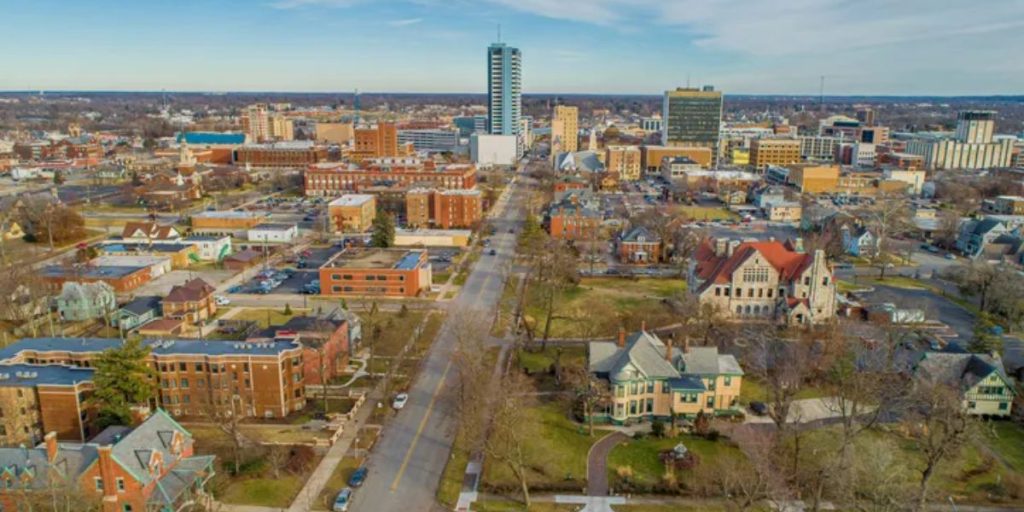Little communities dotting Indiana’s terrain each have a unique narrative to tell. Some of these towns, meanwhile, are seeing a trend that is hard to overlook: citizens packing up and heading for betterment. Some locations are losing appeal as people give access to facilities, quality of life, and financial stability top priority.
In this post, we list five Indiana towns where people are leaving in great numbers, clarifying the causes of these departures and the difficulties these towns have keeping their population.
Harmonyville
The coal mines around Harmonyville were crucial to its success. This sector gave the town well-paying jobs and a strong sense of community for years. However, cleaner energy sources changed things. Coal mines closed, creating unemployment and sorrow. With little work options, young people moved to cities with better prospects. The once-bustling downtown became empty stores and lost its communal vibe.
Whispering Pines
Whispering trees was originally a beautiful rural Indiana postcard with rolling hills and whispering trees. A beautiful river and lush foliage made the town a sanctuary for families and nature lovers. The picturesque exterior hid a mounting threat: environmental devastation.
A adjacent industry surreptitiously dumped industrial trash into the river for decades. Once clean water became muddy and polluted, endangering inhabitants. Residents reported more respiratory difficulties as fish kills became common. Although the local council, mainly influenced by industrial owners, minimized the issue, the harm was clear.
Fear and uncertainty pervaded Whispering Pines. Property values fell as parents worried about their children’s health. As pollution news spread, tourism, the town’s main revenue source, dried up. Early on, families with young children fled for safety, heartbroken. The once cheerful bustle of children playing by the river was replaced by disturbing silence, a clear reminder of paradise lost.
Hollow Creek
Hollow Creek, with its rolling hills and elegant Victorian residences, seemed perfect for a tiny town. Its natural beauty and accessibility to a major highway made it ideal for tourism and business. Poor infrastructure was a major issue.
Hollow Creek lacked critical infrastructure for years. Roads were potholed, bridges creaked beneath car traffic, and the town’s outdated water treatment plant strained to fulfill demand. Businesses were hesitant to invest in a community with poor infrastructure. Tourists drawn by web photographs found a charming but deteriorating town.
The results were terrible. Failures in infrastructure forced businesses to close. Young folks left for better-equipped towns. The departure worsened the town’s finances, making it tougher to fix the issues driving residents away. Hollow Creek, once a promising hamlet, was now mired in decline.
Crossroads

The crossroads of two main highways, Crossroads, was once a thriving industrial and commercial center. Its manufacturers produced furniture, textiles, and other goods, creating jobs and a diversified populace. Active town squares and diverse cultures enlivened the local scene.
However, globalization brought change. Offshoring manufacturing jobs left factories silent and families hurting. Due to limited chances in Crossroads, young people moved to larger cities. With boarded-up storefronts and a stagnant feel, downtown lost its appeal.
The changing demography confronted Crossroads with difficulties and opportunities. The town’s elderly population increased healthcare demand, which might attract new enterprises. Retirees with disposable income could boost the local economy, especially in leisure and entertainment.
But taking advantage of these chances requires a mentality shift. The town council needed to attract demographically relevant firms and industries. Training and education could give the surviving workers the skills needed for the changing employment market. Diversity and accepting newcomers could rejuvenate the town’s culture.
Crossroads might either fall or change direction. The town’s future rested on its capacity to adapt and capitalize on demographic changes.
Must Read: Do You Know About the City With Highest Crime Rate in Indiana?
Eerieville
Misty and historic, Eerieville was charming. Its well-preserved Victorian houses and gaslit streets murmured nostalgia. Unique architecture and charming festivals drew tourists to the town. Despite the gorgeous exterior, inhabitants felt uneasy.
Speculation of unusual events in Eerieville lasted years. Unusual lights flickered in the night sky, electronic items malfunctioned, and several inhabitants saw dark figures fluttering through the mist. Though first dismissive, the local government faced a growing fear and paranoia.
The inexplicable event harmed inhabitants’ mental health and Eerieville’s tourism. The frightening rumors scared tourists who came for the town’s quirkiness. Hotels canceled, and once-bustling stores saw foot traffic plummet. Businesses closed due to declining tourism.
Eerieville, once a fascinating historical site, was now a terrifying place. Families with young children led the steady departure. This charming village was now defined by the mystery that threatened to engulf it.
Conclusion
Harmonyville, Whispering Pines, Hollow Creek, Crossroads, and Eerieville are five Indiana villages with unique problems that have forced residents out. The causes of decline include economic downturns, environmental degradation, infrastructure failure, and demographic upheavals. The result is the same: community hollowing, survival struggle, and loss of vibrancy.